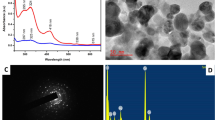Abstract
Brassinosteroids are of universal occurrence in plants. They have been reported to affect plant growth and development through a spectrum of physiological responses. Recently they are reported to confer resistance in plants against a number of biotic and abiotic stresses. In the present study, a brassinosteroid was isolated from Aegle marmelos Correa. (Rutaceae) which was characterized to be 24-epibrassinolide (EBL) using various spectroscopic techniques (TLC and ESI-MS analysis). It was evaluated for the antigenotoxicity against maleic hydrazide (MH) induced genotoxicity in Allium cepa chromosomal aberration assay. It was shown that the percentage of chromosomal aberrations induced by maleic hydrazide (0.01%) declined significantly with 24-epibrassinolide treatment. EBL (10−7 M) proved to be the most effective concentration with 91.8% inhibition. This is the first report on the isolation of 24-epibrassinolide from Aegle marmelos and its antigenotoxic effects against MH employing Allium cepa chromosomal aberration assay.







Similar content being viewed by others
References
Alam MM, Hayat S, Ali B, Ahmad A (2007) Effect of 28-homobrassinolide treatment on nickel toxicity in Brassica juncea (L.). Photosynthetica 45(1):139–142
Ali MS, Pervez MK (2004) Marmelon: a 7-geranyloxycoumarin from the leaves of Aegle marmelos Corr. Nat Prod Res 18(2):141–149
Bajguz A, Tretyn A (2003) The chemical characteristic and distribution of brassinosteroids in plants. Phytochem 62:1027–1046
Bhardwaj R, Kaur S, Nagar PK, Arora HK (2007) Isolation and characterization of brassinosteroids from immature seeds of Camellia sinensis (O) Kuntze. Plant Growth Regul 53:1–5
Clouse S, Sasse J (1998) Brassinosteroids: essentials regulators of plant growth and development. Annu Rev Pl Physiol Pl Mol Biol 49:427–451
Fiskesjo G (1985) The Allium test as a standard in environmental monitoring. Hereditas 102:99–112
Gupta D, Bhardwaj R, Nagar PK, Kaur S (2004) Isolation and characterization of brassinosteroids from leaves of Camellia sinensis (L.) O Kuntze. Plant Growth Regul 43:97–100
Hayat S, Ali B, Hasan SA, Ahmad A (2007) Brassinosteroid enhanced the level of antioxidants under cadmium stress in Brassica juncea (L.). Environ Exp Bot 60:33–41
Howell WM, Keller III GE, Kirkpatrick JD, Jenkins RL, Hunsinger RN, McLaughlin EW (2007) Effects of the plant steroidal hormone, 24-epibrassinolide, on the mitotic index and growth of onion (Allium cepa) root tips. Genet Mol Res 6:50–58
Kagale S, Divi UK, Krochko JE, Keller WA, Krishna P (2007) Brassinosteroid confers tolerance in Arabidopsis thaliana and Brassica napus to a range of abiotic stresses. Planta 225:353–364
Kamuro Y, Takatsuto S (1999) Practical application of brassinosteroids in agricultural fields. In: Sakurai A, Yokota T, Clouse SD (eds) Brassinosteroids: steroidal plant hormones. Springer Verlag, Toyko, pp 223–241
Khrustaleva LI, Andreeva GN, Golovinina YM, Zlobin AI, Pogorilaya EV (1991) Cytogenetic investigation in somatic and generative cells of barley, treated by epibrassinolide in field conditions. In: Workshop on Brassinosteroids, 2nd. Minsk, 31 pp
Kihlman BA, Sturelid S (1978) Effects of caffeine on the frequency of chromosomal aberrations and sister chromatid exchanges induced by chemical mutagens in root-tips of Vicia faba. Hereditas 88:35–41
Krishna P (2003) Brassinosteroids––mediated stress responses. J Plant Growth Regul 22:289–297
Mayers LS, Grossen NE (1974) Analysis of independent group designs. In: Behavioural research, theory, procedure and design. W.H. Freeman, San Francisco, pp 237–252
Murugesa Mudaliar KS (1988) Materia medica of Tamil Systems of Medicine. Part I. Tamil Nadu Siddha Medical Board, Government of Tamil Nadu, India, pp 638–642
Sakurai A, Fujioka S (1993) The current status of physiology and biochemistry of brassinosteroid. Plant Growth Regul 13:147–159
Sakurai A, Fujioka S (1997) Studies on biosynthesis of brassinosteroids. Biosci Biotech Biochem 61:757–762
Singh RP, Banerjee S, Rao AR (2000) Effect of Aegle marmelos on biotransformation enzyme systems and protection against free radical mediated damage in mice. J Pharm Pharmacol 52:991–1000
Swaczynova J, Malikova J, Hoffmannova L, Kohout L, Strnad M (2006) Anticancer properties of Brassinosteroids. Planta Med 72
Takatsuto S, Yazawa N, Ikekawa N, Takematsu T, Takeuchi Y, Koguchi M (1983) Structure–activity relationship of brassinosteroids. Phytochemistry 22:2437–2441
Tanaka K, Nakamura Y, Asami T, Yoshidi S, Matsuo T, Okamoto S (2003) Physiological roles of brassinosteroids in early growth of Arabidopsis: brassinosteroids have a synergistic relationship with gibberllins as well as auxin in light-growth hypocotyls elongation. J Plant Growth Regul 22:259–271
Veerapan A, Shigeru M, Renganathan D (2005) Studies on the anti-inflammatory, antipyretic and analgesic properties of the leaves of Aegle marmelos Corr. J Ethnopharmacol 96:159–163
Venkatesh P, Shantala B, Jagetia GC, Rao KK, Baliga MS (2007) Modulation of doxorubicin-induced genotoxicity by Aegle marmelos (L.) in bone marrow: a micronucleus study. Integr Cancer Ther 6(1):42–53
Wachsman MB, Ramirez JA, Galagovsky LR, Coto CE (2002) Antiviral activity of brassinosteroids derivatives against measles virus in cell cultures. Antivir Chem Chemother 13:61–67
Wachsman MB, Castilla V, Talarico LB, Ramirez JA, Galagovsky LR, Coto CE (2004) Antiherpatic mode of action of (22S, 23S)-3β-Bromo-5α, 22,23-trihydroxystigmastan-6-one in vitro. Int J Antimicrob Agents 23:524–526
Acknowledgements
This work is supported by grants from University Grants Commission, Government of India. Dr. P. S. Ahuja, Director, Institute of Himalayan Bioresource Technology (IHBT) Palampur (HP) is duly acknowledged for providing necessary lab facilities.
Author information
Authors and Affiliations
Corresponding author
Rights and permissions
About this article
Cite this article
Sondhi, N., Bhardwaj, R., Kaur, S. et al. Isolation of 24-epibrassinolide from leaves of Aegle marmelos and evaluation of its antigenotoxicity employing Allium cepa chromosomal aberration assay. Plant Growth Regul 54, 217–224 (2008). https://doi.org/10.1007/s10725-007-9242-7
Received:
Accepted:
Published:
Issue Date:
DOI: https://doi.org/10.1007/s10725-007-9242-7




